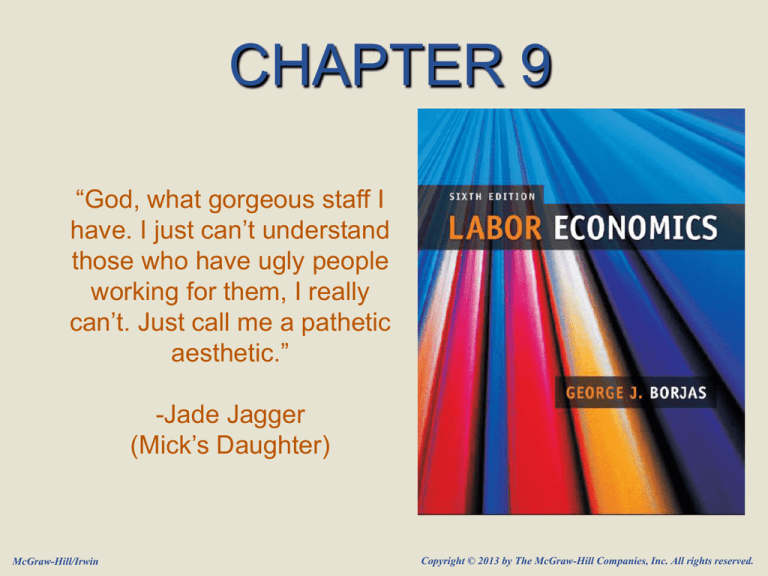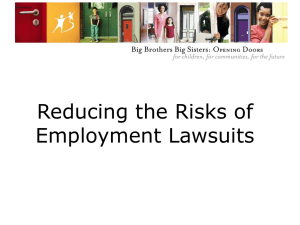
CHAPTER 9
“God, what gorgeous staff I
have. I just can’t understand
those who have ugly people
working for them, I really
can’t. Just call me a pathetic
aesthetic.”
-Jade Jagger
(Mick’s Daughter)
McGraw-Hill/Irwin
Copyright © 2013 by The McGraw-Hill Companies, Inc. All rights reserved.
Introduction
• Discrimination occurs when the marketplace takes into
account such factors as race and sex when making
economic exchanges.
9-2
Race and Gender
in the Labor Market
• Men earn more than women, and whites usually earn
more than nonwhites.
• Differences in educational attainment between whites
and nonwhites account for a portion of the wage
differential.
9-3
The Discrimination
Coefficient
• Taste discrimination translates the notion
of racial prejudice.
o Racial prejudice causes employers to blindly
perceive the costs of hiring blacks as being
higher than the true cost.
o Even though it costs wb dollars to hire one
person-hour of black labor, the employer
acts as if it costs wb(1+d) dollars, where d,
d>0, is the discrimination coefficient.
9-4
Employer Discrimination
• Implication of the Becker model
• If blacks and whites are perfect substitutes,
employers have a segregated work force.
o Even non-discriminating employers have a segregated work force,
as they employ all black workers
• Discrimination does not pay.
o Employers hire the wrong type of worker and/or they hire the wrong
number of workers.
9-5
The Employment Decision for a
Firm That Does Not Discriminate
Dollars
wB
VMPE
EB
If the market-determined black
wage is less than the white
wage, a firm that does not
discriminate will hire only
blacks. It hires black workers
up to the point where the black
wage equals the value of
marginal product of labor, E*B.
Employment
9-6
The Employment Decision for a Prejudiced Firm
Dollars
Dollars
wW
wB(1+d1)
wB(1+d0)
wB
VMPE
VMPE
EW
Employment
(a) White Firm
EB1
EB
EB*
Employment
(b) Black Firm
Firms that discriminate can be either white firms (if the discrimination coefficient is very high) or
black firms (if the discrimination coefficient is relatively low). A white firm hires white workers up to
the point where the white wage equals the value of marginal product. A black firm hires black
workers up to the point where the utility-adjusted black wage equals the value of marginal product.
Firms that discriminate hire fewer workers than firms that do not discriminate.
9-7
Profits and Discrimination
Dollars
Discrimination reduces
profits in potentially two
ways. A discriminatory firm
that hires only white
workers will hire too few
workers at a very high
wage. Even a discriminatory
firm that only hires black
workers is harmed by its
actions as it hires too few
workers.
MAX
W
Black
Firms
0
White
Firms
dW
Discrimination
Coefficient
9-8
The Black-White Wage
Ratio in the Labor Market
• Employer discrimination generates a wage gap
between equally skilled black and white workers.
• The quantity demanded for black labor
increases as the black-while wage ratio falls.
9-9
Determination of Black/White
Wage Ratio in the Labor Market
Black-White
Wage Ratio
S
(wB/wW)
1
D
R
(wB/wW)*
D
0
N
Black
Employment
If the black-white wage ratio is very
high, no firm in the labor market will
want to hire blacks. As the black-white
wage ratio falls, more and more firms
are compensated for their disutility and
the demand for black workers rises.
The equilibrium black-white wage ratio
is given by the intersection of supply
and demand, and equals (wB/wW)*. If
some firms prefer to hire blacks, they
would be willing to hire blacks even if
the black-white wage ratio exceeds 1,
shifting the demand curve up to D. If
the supply of blacks is sufficiently
small, it is then possible for the blackwhite wage ratio to exceed 1.
9-10
Employee Discrimination
• Employee discrimination does not generate a
wage differential between equally skilled black
and white workers.
• Employee discrimination does not affect the
profitability of firms.
• Work places will be segregated
9-11
Customer Discrimination
• If customers discriminate, their perceived price of a good
is utility-adjusted with a discrimination coefficient.
• When a firm cannot hide black workers, customer
discrimination can have an adverse effect on black
wages.
9-12
Statistical Discrimination
• Statistical discrimination is based on treating an
individual on the basis of membership in a group and
knowledge of that group’s history.
9-13
The Impact of Statistical Discrimination on Wages
Dollars
Dollars
White
White
Black
T*
(a) Whites have higher average score
Test Score
Black
T
Test Score
(b) Test is better predictor for white workers
The worker’s wage depends not only on his own test score, but also on the mean test
score of workers in his racial group. (a) If black workers, on average, score lower than
white workers, a white worker who gets a score of T* earns more than a black worker
with the same score. (b) If the test is a better predictor of productivity for white workers,
high-scoring whites earn more than high-scoring blacks, and low-scoring whites earn less
than low-scoring blacks.
9-14
Measuring Discrimination
• One possible measure of discrimination is the
difference in mean wages.
• A better measure would compare the wages of
equally skilled workers.
• Oaxaca decomposition: a technique that
decomposes the raw wage differential into a
portion related to a difference in skills and a
portion attributable to labor market
discrimination.
9-15
Measuring the Impact of Gender
Discrimination on the Wage
Dollars
Men’s Earnings
Function
w
M
wF
Women’s Earnings
Function
M
w
F
F
s F
s M
The average woman has sF
years of schooling and earns
w–F. The average man has sM
years of schooling and earns
w–M. Part of the wage
differential arises because men
have more schooling than
women. If the average woman
was paid as if she were a man,
she would earn w*F. A
measure of discrimination is
then given by w*F–w–F.
Schooling
9-16
Policy Application: Determinants
of the White-Black Wage Ratio
• There has been an upward trend in the wages of blacks
in recent years.
• This has been attributed to increases in the quality and
quantity of black schooling.
• Government programs have positively affected black
wages.
9-17
The Oaxaca Decomposition of the
Black-White Wage Differential, 1995
Controls for Differences Controls for Differences
in Education, Age, Sex, in Education, Age, Sex,
and Region of
Region, and Occupation
Residence
and Industry
Raw log wage differential
-0.211
-0.211
Due to differences in skills
-0.082
-0.144
Due to discrimination
-0.134
-0.098
Source: Joseph G. Altonji and Rebecca M. Blank, “Race and Gender in the Labor Market,” in Orley Ashenfelter and David
Card, editors, Handbook of Labor Economics, vol. 3C, Amsterdam: Elsevier, 1999, Table 5. The log wage differential
between any two groups can be interpreted as being approximately equal to the percentage wage differential between the
groups.
9-18
The Trend in the Black-White
Earnings Ratio, 1967-2009
1
0.95
Black-white earnings raatio
0.9
Women
0.85
0.8
0.75
Men
0.7
0.65
0.6
1965
1970
1975
1980
1985
1990
Year
1995
2000
2005
2010
2015
9-19
Male Labor Force Participation
Rates, by Race, 1955-2009
90
85
Participation Rate
80
Whites
75
70
Blacks
65
60
1950
1960
1970
1980
Year
1990
2000
2010
9-20
The Decline in the Labor Force Participation
of Blacks and the Average Black Wage
Frequency
w~1
w~2
w1
w2
Wage rate
9-21
Discrimination Against
Other Groups
• Differences in wages can be linked to varying
educational attainment.
• Less skilled workers earn less, just as human capital
theory proposes.
• Asians tend to earn more than white, mainly due to
schooling.
9-22
The Trend in the Earnings Ratio of
Hispanics and Asians, 1974-2009
1.2
Asian women
1.1
Earnings Ratio
1
Asian men
0.9
0.8
Hispanic Women
0.7
Hispanic men
0.6
1970
1975
1980
1985
1990
1995
2000
2005
2010
2015
Year
9-23
Policy Application: Determinants
of the Male-Female Wage Ratio
• Occupational crowding has segregated women into
particular occupations where the return to education is
lower.
• Human capital is more profitable the longer the payoff
period.
• Women are better off if they enter occupations in which
their skills do not deteriorate during the years they spend
in the household sector.
9-24
Trend in the Female-Male
Earnings Ratio, 1960-2009
0.8
Female-Male Earnings Ratio
0.75
0.7
0.65
0.6
0.55
0.5
1960
1970
1980
1990
Year
2000
2010
2020
9-25









